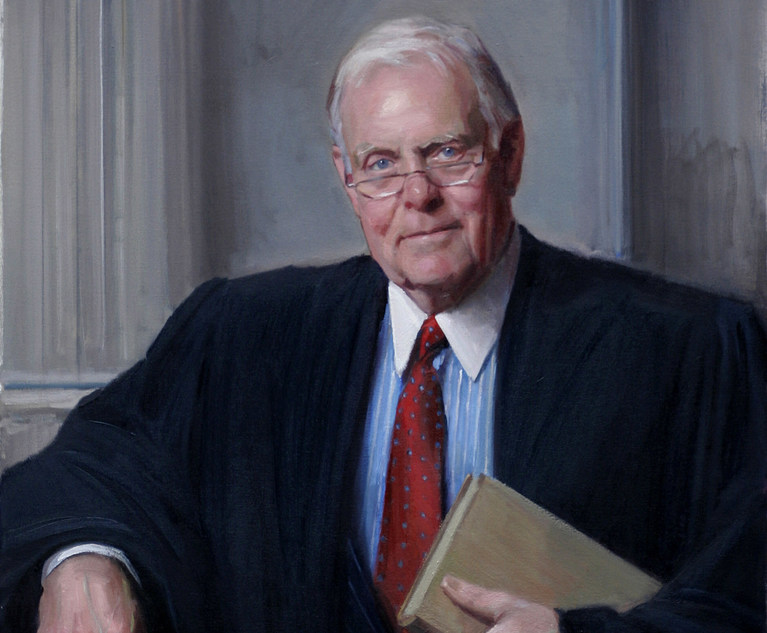Thank you for reading The Marble Palace Blog, which I hope will inform and surprise you about the Supreme Court of the United States. My name is Tony Mauro. I’ve covered the Supreme Court since 1979 and for ALM since 2000. I semiretired in 2019, but I am still fascinated by the high court. I’ll welcome any tips or suggestions for topics to write about. You can reach me at [email protected].
In 1993, Gilbert Merritt Jr., a judge on the U.S. Court of Appeals for the Sixth Circuit, was on President Bill Clinton’s short list to fill a vacancy on the Supreme Court when Byron White retired. But Merritt had strong competition for the seat: Ruth Bader Ginsburg, Stephen Breyer and Richard Arnold, among others.
Ginsburg got the nod (Breyer got it the next year), and Merritt remained comfortably on the Sixth Circuit, working from his Nashville chambers. After 44 years on the bench, Merritt died on Jan. 17 on his 86th birthday.
Jeff Sutton, chief judge of the Sixth Circuit, praised Merritt as “a brilliant jurist, a devoted champion of justice, a beloved colleague, and a local, regional, and national leader of the federal judiciary for forty years. … He saw all sides to every case; he treated everyone with respect; he was kind when kindness was called for, bold when boldness was due.”
Keel Hunt, author of a forthcoming biography of Merritt, said, “To me, the real measure of the man—apart from his deep scholarship and long judicial record—was the genuine respect he had from both colleagues on the court and also the dozens of women and men who worked as law clerks in his chambers over 40-plus years.”
Michael Gerhardt, professor at the University of North Carolina School of Law who clerked for Merritt, said the judge was “a great mentor, boss, friend, and jurist.”
Merritt was an advocate for sentencing reform, and an opponent of the death penalty. “Judge Merritt understood that the law, particularly as it applies to the death penalty, has too often become a procedural mechanism to maintain convictions and death sentences, even when fairness and truth get in the way,” said Stacy Rector, executive director of Tennesseans for Alternatives to the Death Penalty.
During the landmark Bush v. Gore Supreme Court case in 2001, Merritt played a brief role when The New York Times reported that Justice Clarence Thomas’ wife Virginia was working for the conservative Heritage Foundation. Someone in the Gore campaign suggested that the reporter contact Merritt, who happened to be a longtime friend of the Gore family, to comment on whether Thomas should be recused because of his wife’s relationship with Heritage.
Merritt told the reporter that ”The spouse has obviously got a substantial interest that could be affected by the outcome. I think [Thomas] would be subject to some kind of investigation in the Senate.” Merritt did not launch a complaint against Thomas.
In 1996, then-Chief Justice William Rehnquist appointed Merritt to chair the executive committee of the Judicial Conference, the policy arm of the federal judiciary. It was a period when the conference was debating whether cameras should be allowed to broadcast court proceedings.
In a 1998 article, I quoted Merritt as someone who supported camera access, especially at the appeals court level where concerns about the impact on jurors and witnesses is not an issue because jurors and witnesses don’t attend appellate proceedings.
But Merritt, known for respecting both sides of an issue, said he understood why judges were against camera access, even when a three-year experiment was viewed as a success for broadcasting proceedings.
“There’s a sort of nuanced, Federalist Papers kind of feeling among federal judges that we’re supposed to be the last bastion of independence, not responding to majority will, and that carries over to the camera question,” he told me. “It’s not such a bad thing.”
NOT FOR REPRINT
© 2024 ALM Global, LLC, All Rights Reserved. Request academic re-use from www.copyright.com. All other uses, submit a request to [email protected]. For more information visit Asset & Logo Licensing.


 Portrait of Gilbert Merritt Jr., chief judge of the U.S. Court of Appeals for the Sixth Circuit, by Michael Shane Neal. Credit: Michael Shane Neal via Wikipedia
Portrait of Gilbert Merritt Jr., chief judge of the U.S. Court of Appeals for the Sixth Circuit, by Michael Shane Neal. Credit: Michael Shane Neal via Wikipedia






